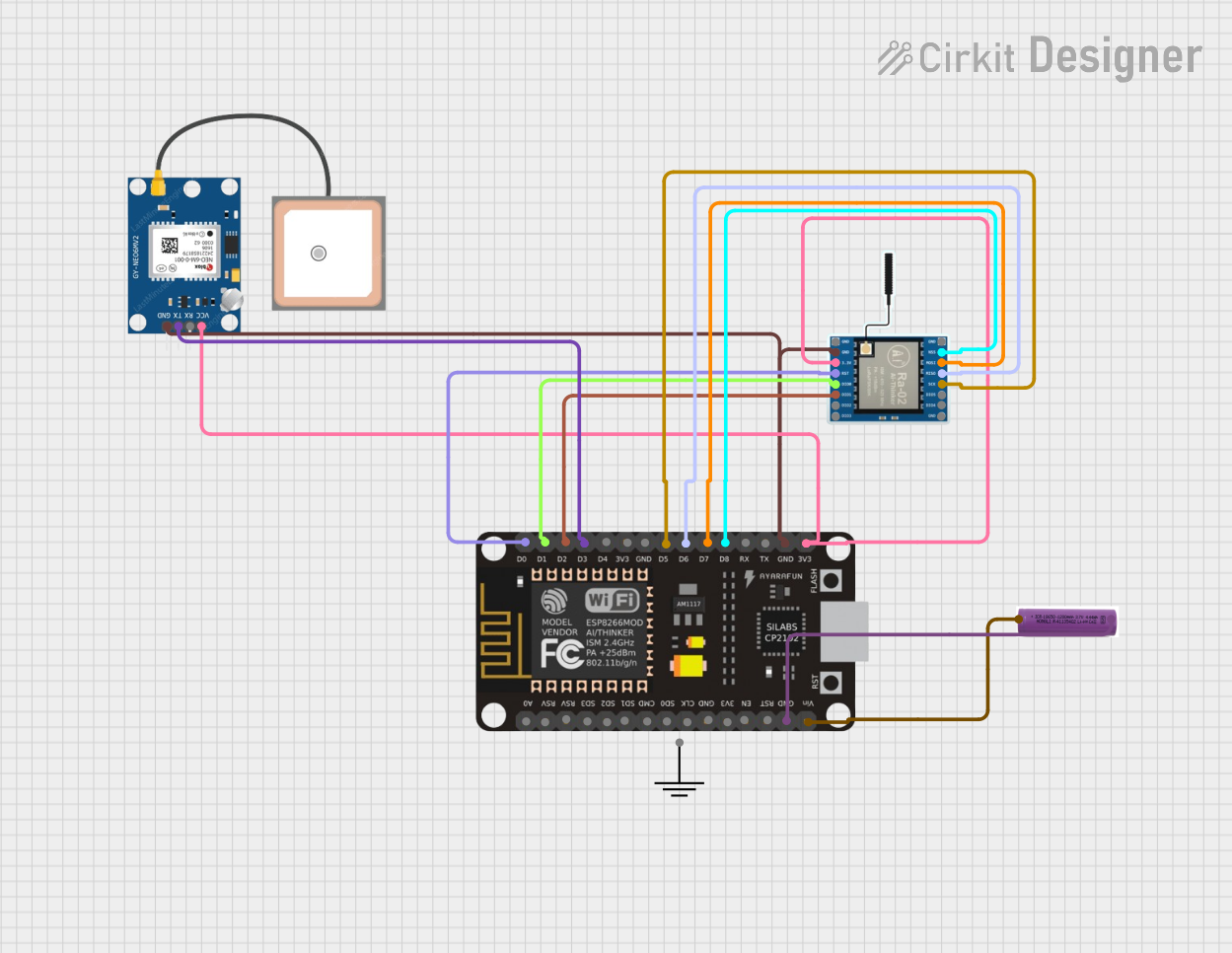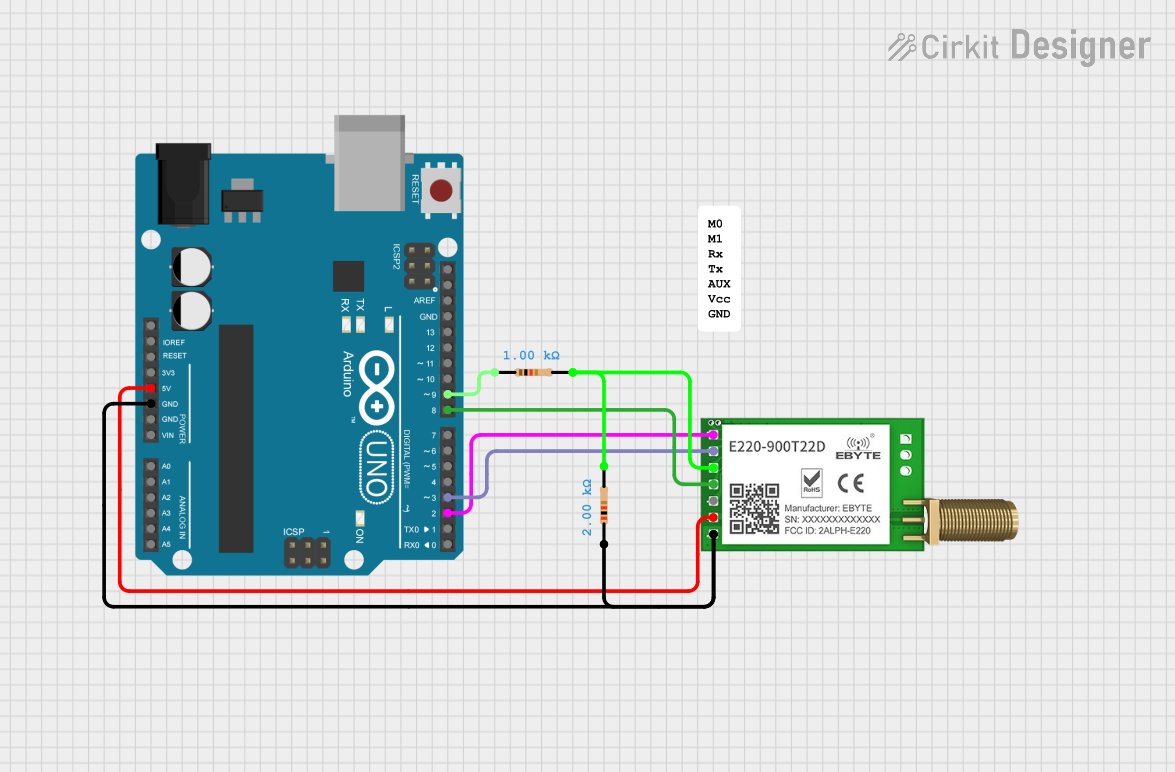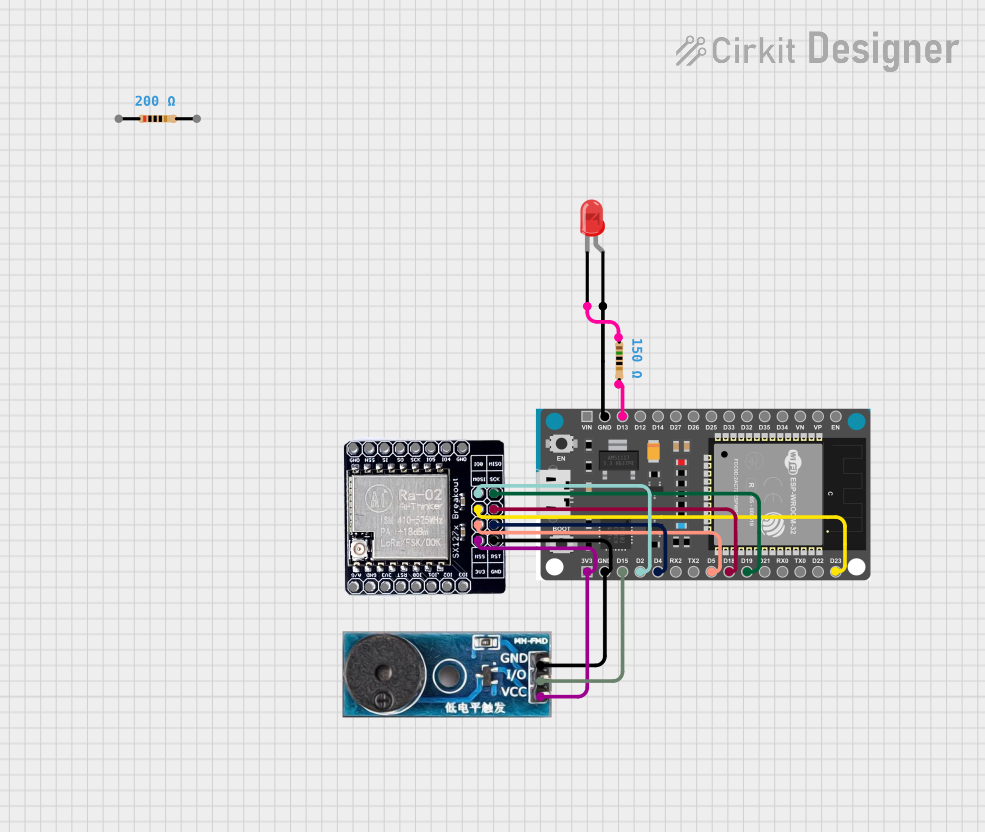
How to Use lora module: Examples, Pinouts, and Specs

 Design with lora module in Cirkit Designer
Design with lora module in Cirkit DesignerIntroduction
The Ai-Thinker Ra-02 is a LoRa (Long Range) module designed for low-power, long-range wireless communication. It operates in the sub-GHz frequency bands (typically 433 MHz, 868 MHz, or 915 MHz, depending on regional regulations) and is based on the Semtech SX1278 LoRa transceiver chip. This module is ideal for Internet of Things (IoT) applications, enabling devices to communicate over distances of up to several kilometers with minimal power consumption.
Explore Projects Built with lora module

 Open Project in Cirkit Designer
Open Project in Cirkit Designer
 Open Project in Cirkit Designer
Open Project in Cirkit Designer
 Open Project in Cirkit Designer
Open Project in Cirkit Designer
 Open Project in Cirkit Designer
Open Project in Cirkit DesignerExplore Projects Built with lora module

 Open Project in Cirkit Designer
Open Project in Cirkit Designer
 Open Project in Cirkit Designer
Open Project in Cirkit Designer
 Open Project in Cirkit Designer
Open Project in Cirkit Designer
 Open Project in Cirkit Designer
Open Project in Cirkit DesignerCommon Applications and Use Cases
- Smart agriculture (e.g., soil moisture sensors, weather stations)
- Industrial automation and monitoring
- Smart cities (e.g., parking sensors, streetlight control)
- Asset tracking and fleet management
- Environmental monitoring (e.g., air quality sensors)
- Remote control and telemetry systems
Technical Specifications
The following table outlines the key technical details of the Ai-Thinker Ra-02 module:
| Parameter | Value |
|---|---|
| Operating Frequency | 433 MHz / 868 MHz / 915 MHz (region-specific) |
| Modulation Technique | LoRa (Long Range) |
| RF Output Power | Up to +20 dBm |
| Sensitivity | -139 dBm |
| Data Rate | 0.018 kbps to 37.5 kbps |
| Operating Voltage | 1.8V to 3.7V |
| Current Consumption | 10.8 mA (transmit), 10.3 mA (receive) |
| Sleep Mode Current | < 200 nA |
| Communication Interface | SPI |
| Operating Temperature | -40°C to +85°C |
| Dimensions | 17.8 mm x 16.5 mm x 2.3 mm |
Pin Configuration and Descriptions
The Ra-02 module has 16 pins. The table below describes each pin:
| Pin Number | Pin Name | Description |
|---|---|---|
| 1 | GND | Ground (0V reference) |
| 2 | DIO5 | Digital I/O pin 5 (configurable interrupt) |
| 3 | DIO4 | Digital I/O pin 4 (configurable interrupt) |
| 4 | DIO3 | Digital I/O pin 3 (configurable interrupt) |
| 5 | DIO2 | Digital I/O pin 2 (configurable interrupt) |
| 6 | DIO1 | Digital I/O pin 1 (configurable interrupt) |
| 7 | DIO0 | Digital I/O pin 0 (configurable interrupt) |
| 8 | NSS | SPI Chip Select (active low) |
| 9 | MISO | SPI Master In Slave Out |
| 10 | MOSI | SPI Master Out Slave In |
| 11 | SCK | SPI Clock |
| 12 | RESET | Reset pin (active low) |
| 13 | 3.3V | Power supply (1.8V to 3.7V) |
| 14 | ANT | Antenna connection |
| 15 | GND | Ground (0V reference) |
| 16 | NC | Not connected |
Usage Instructions
How to Use the Ra-02 Module in a Circuit
- Power Supply: Connect the
3.3Vpin to a regulated 3.3V power source. Ensure theGNDpins are connected to the ground of your circuit. - SPI Communication: Connect the
NSS,MISO,MOSI, andSCKpins to the corresponding SPI pins on your microcontroller. - Antenna: Attach a suitable antenna to the
ANTpin for optimal signal transmission and reception. - Reset: Use the
RESETpin to initialize the module. Pull it low momentarily to reset the module. - Digital I/O Pins: Configure the
DIOpins as needed for interrupts or other functions.
Important Considerations and Best Practices
- Antenna Selection: Use a high-quality antenna tuned to the operating frequency (e.g., 433 MHz or 868 MHz) for maximum range and performance.
- Power Supply: Ensure a stable and noise-free power supply to avoid communication issues.
- Regulatory Compliance: Verify that the operating frequency and transmission power comply with local regulations.
- SPI Speed: Use an SPI clock speed of up to 10 MHz for reliable communication.
- Heat Dissipation: Avoid placing the module near heat-generating components to maintain optimal performance.
Example: Connecting the Ra-02 to an Arduino UNO
Below is an example of how to connect the Ra-02 module to an Arduino UNO and send data using the LoRa library.
Wiring Diagram
| Ra-02 Pin | Arduino UNO Pin |
|---|---|
| 3.3V | 3.3V |
| GND | GND |
| NSS | D10 |
| MISO | D12 |
| MOSI | D11 |
| SCK | D13 |
| RESET | D9 |
| DIO0 | D2 |
Arduino Code
#include <SPI.h>
#include <LoRa.h>
// Define pins for the Ra-02 module
#define NSS_PIN 10
#define RESET_PIN 9
#define DIO0_PIN 2
void setup() {
// Initialize serial communication for debugging
Serial.begin(9600);
while (!Serial);
// Initialize the LoRa module
Serial.println("Initializing LoRa...");
LoRa.setPins(NSS_PIN, RESET_PIN, DIO0_PIN); // Set SPI and control pins
if (!LoRa.begin(433E6)) { // Set frequency to 433 MHz
Serial.println("LoRa initialization failed!");
while (1);
}
Serial.println("LoRa initialized successfully!");
}
void loop() {
// Send a test message
Serial.println("Sending message...");
LoRa.beginPacket();
LoRa.print("Hello, LoRa!");
LoRa.endPacket();
delay(5000); // Wait 5 seconds before sending the next message
}
Troubleshooting and FAQs
Common Issues and Solutions
No Communication with the Module:
- Ensure the SPI connections are correct and match the microcontroller's SPI pins.
- Verify that the
NSS,RESET, andDIO0pins are properly connected.
Poor Signal Range:
- Check the antenna connection and ensure it is tuned to the correct frequency.
- Avoid obstructions and interference sources in the signal path.
Module Not Initializing:
- Confirm that the power supply voltage is within the specified range (1.8V to 3.7V).
- Ensure the
RESETpin is not held low during normal operation.
High Power Consumption:
- Verify that the module enters sleep mode when not actively transmitting or receiving.
- Check for any short circuits or incorrect wiring.
FAQs
Q: Can the Ra-02 module be used with 5V microcontrollers?
A: The Ra-02 operates at 3.3V. If using a 5V microcontroller, level shifters are required for the SPI and control pins.
Q: What is the maximum range of the Ra-02 module?
A: The range depends on factors such as antenna quality, operating frequency, and environmental conditions. In open areas, it can reach up to 10 km.
Q: Can multiple Ra-02 modules communicate with each other?
A: Yes, multiple modules can communicate as long as they are configured to the same frequency, spreading factor, and other LoRa parameters.
Q: Is the Ra-02 module compatible with LoRaWAN?
A: The Ra-02 supports LoRa modulation but does not natively support the LoRaWAN protocol. Additional software or hardware is required for LoRaWAN compatibility.